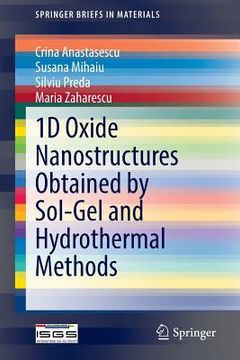Share
1d Oxide Nanostructures Obtained by Sol-Gel and Hydrothermal Methods (in English)
Crina Anastasescu
(Author)
·
Susana Mihaiu
(Author)
·
Silviu Preda
(Author)
·
Springer
· Paperback
1d Oxide Nanostructures Obtained by Sol-Gel and Hydrothermal Methods (in English) - Anastasescu, Crina ; Mihaiu, Susana ; Preda, Silviu
$ 52.09
$ 54.99
You save: $ 2.90
Choose the list to add your product or create one New List
✓ Product added successfully to the Wishlist.
Go to My WishlistsIt will be shipped from our warehouse between
Thursday, June 13 and
Friday, June 14.
You will receive it anywhere in United States between 1 and 3 business days after shipment.
Synopsis "1d Oxide Nanostructures Obtained by Sol-Gel and Hydrothermal Methods (in English)"
This book presents wet chemical sol-gel and hydrothermal methods for 1D oxide nanostructure preparation. These methods represent an attractive route to multifunctional nanomaterials synthesis, as they are versatile, inexpensive and, thus, appropriate for obtaining a wide range of oxide materials with tailored morphology and properties. Three specific oxides (SiO2, TiO2, ZnO) are discussed in detail in order to illustrate the principle of the sol-gel and hydrothermal preparation of 1D oxide nanostructures. Other oxides synthesized via this method are also briefly presented. Throughout the book, the correlation between the tubular structure and the physico-chemical properties of these materials is highlighted. 1D oxide nanostructures exhibit interesting optical and electrical properties, due to their confined morphology. In addition, a well-defined geometry can be associated with chemically active species. For example, the pure SiO2 nanotubes presented a slight photocatalytic activity, while the Pt-doped SiO2 tubular materials act as microreactors in catalytic reactions. In the case of titania and titanate nanotubes, large specific surface area and pore volume, ion-exchange ability, enhanced light absorption, and fast electron-transport capability have attracted significant research interest. The chemical and physical modifications (microwave assisted hydrothermal methods) discussed here improve the formation kinetics of the nanotubes. The ZnO nanorods/tubes were prepared as random particles or as large areas of small, oriented 1D ZnO nanostructures on a variety of substrates. In the latter case a sol-gel layer is deposited on the substrate prior to the hydrothermal preparation. Using appropriate dopants, coatings of ZnO nanorods with controlled electrical behavior can be obtained.

